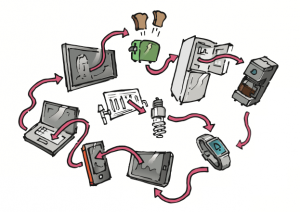05 Nov Everything is Mobile: What Does That Mean for Marketers?
 Our definition of “mobile technology” is swiftly advancing. Whereas “mobile technology” was once reserved for cell phones, and later tablet devices, the word on the street is that everything is becoming mobile.
Our definition of “mobile technology” is swiftly advancing. Whereas “mobile technology” was once reserved for cell phones, and later tablet devices, the word on the street is that everything is becoming mobile.
What is considered a mobile technology today, and what should marketers be thinking about when it comes to these new communication channels?
Phones and tablets
Phones and tablets are the grandfather, if you will, of mobile technology. Today communicators need to consider the different types of devices, and take measures to ensure content works across devices. Websites and HTML email templates should be “responsive,” meaning they should look great on all devices (such as Androids, iPhones including the new plus sizes, tablets, and Kindles) browsers (such as Chrome, Firefox, Safari, and Internet Explorer), and email services (such as Outlook, Gmail, and iCloud).
Take a look at your Google Analytics to see what devices and browsers your visitors predominantly use to prioritize ensure your website is responsive to your most frequent visitors. To see these details go to audience –> overview –> mobile.
Cars
While it is obvious that a car is inherently mobile, have you thought about the various new communications tools cars contain?
Navigation systems are already being used to display advertisements. Check out Think Near, a company that allows advertisers to deliver location-based ads. BMW is also working on developing in-car advertisements.
Tesla has started rolling out cars with a unique browser just for Tesla users. Early data shows that Tesla users read news on these “connected cars” during their commute.
Do you have a local business? Targeting commuters via in-car systems might be a smart use of your advertising dollars. Do you have a news story to tell that might appeal to drivers of a certain brand of car? Someday you might break down your target audience to include women who drive to elementary schools in BMW SUVs, for example.
Wearable Devices
We’ve talked about the impact of wearable technology for marketers before. As we predicted, they are continuing to evolve past smart watches and Google Glass. Wearables will continue to be used for health and fitness tracking while moving into the spaces of early detection, personalized health care and amplified surgery capabilities.
Beyond the practical applications, wearable devices will soon enable augmented reality experiences, such as playing a video game that might be sponsored by a brand.
Smart clothes are also on the way that might charge a phone, protect against sporting injuries, or point wearers in the right direction when traveling from one point to another. Ralph Lauren is even getting into the wearables game with their signature polo shirts.
Consider existing wearable technology, and brainstorm how gathering moment-to-moment user generated data might help you improve messaging, or amplify your communication. For example: Say you sell sneakers. Your brand could partner with a wearable technology provider that tracks steps to remind users it’s time for a new pair of shoes when they hit 3,000 miles.
Mobile Connected Smart Objects
Some mobile technology isn’t portable. Smart objects (objects that can send and receive data) such as coffee pots, refrigerators and alarm systems, are becoming more sophisticated, connecting to mobile applications. For example, GE’s smart appliances connect to a proprietary mobile application, and serve as a good example of how these smart objects will be used.
As the ability to control objects goes mobile, users will even be able to post messages on social networks from some smart objects, and smart objects may even alert users to improve its performance or usefulness.
A recent Gartner study revealed by 2020 the average affluent household will have several hundred smart objects. Click to Tweet this!
Think of the connected smart object as a new communications channel. Imagine having the ability to target people who make coffee at 6 am on the east coast with a key message. Soon this possibility will be a reality.






